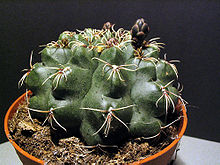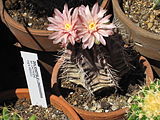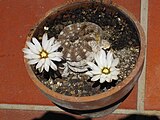Gymnocalycium: Difference between revisions
added photos |
shifted photo |
||
| Line 51: | Line 51: | ||
Their main area of distribution is [[Argentina]], part of [[Uruguay]], [[Paraguay]], southern [[Bolivia]] and part of [[Brazil]]. Most species are rather small varying from 4 to 15 centimetres in size. In cultivation they are popular for their easy flowering habits, and the [[flower]]s are generally brightly coloured. Where temperatures fall below {{convert|10|C|F|abbr=on}} they must be cultivated under glass with heat.<ref name=RHSAZ>{{cite book|title=RHS A-Z encyclopedia of garden plants|year=2008|publisher=Dorling Kindersley|location=United Kingdom|isbn=1405332964|pages=1136}}</ref> |
Their main area of distribution is [[Argentina]], part of [[Uruguay]], [[Paraguay]], southern [[Bolivia]] and part of [[Brazil]]. Most species are rather small varying from 4 to 15 centimetres in size. In cultivation they are popular for their easy flowering habits, and the [[flower]]s are generally brightly coloured. Where temperatures fall below {{convert|10|C|F|abbr=on}} they must be cultivated under glass with heat.<ref name=RHSAZ>{{cite book|title=RHS A-Z encyclopedia of garden plants|year=2008|publisher=Dorling Kindersley|location=United Kingdom|isbn=1405332964|pages=1136}}</ref> |
||
| ⚫ | |||
==References== |
==References== |
||
| Line 68: | Line 67: | ||
File:Gymnocalycium leeanum.JPG|''Gymnocalycium leeanum'' |
File:Gymnocalycium leeanum.JPG|''Gymnocalycium leeanum'' |
||
File:Gymnocalycium ragonesii 2.JPG|''Gymnocalycium ragonesei'' |
File:Gymnocalycium ragonesii 2.JPG|''Gymnocalycium ragonesei'' |
||
| ⚫ | |||
</gallery> |
</gallery> |
||
Revision as of 21:00, 5 October 2013
| Gymnocalycium | |
|---|---|

| |
| Gymnocalycium baldianium | |
| Scientific classification | |
| Kingdom: | |
| (unranked): | |
| (unranked): | |
| (unranked): | |
| Order: | |
| Family: | |
| Subfamily: | |
| Tribe: | |
| Genus: | Gymnocalycium |
| Species | |
|
About 70, including: | |
| Synonyms | |
|
Brachycalycium Backeb. | |
Gymnocalycium, commonly called chin cactus, is a genus of about 70 South American species of cacti. The genus name Gymnocalycium (from Greek, "naked calyx") refers to the flower buds bearing no hair or spines.
Their main area of distribution is Argentina, part of Uruguay, Paraguay, southern Bolivia and part of Brazil. Most species are rather small varying from 4 to 15 centimetres in size. In cultivation they are popular for their easy flowering habits, and the flowers are generally brightly coloured. Where temperatures fall below 10 °C (50 °F) they must be cultivated under glass with heat.[1]
References
- ^ RHS A-Z encyclopedia of garden plants. United Kingdom: Dorling Kindersley. 2008. p. 1136. ISBN 1405332964.
-
Gymnocalycium species from Liberec botanical garden
-
Gymnocalycium species from Liberec botanical garden
-
Gymnocalycium species from Liberec botanical garden
-
Gymnocalcium Oneanthemum from the Brooklyn Botanic Garden
-
Gymnocalycium mihanovichii in flower
-
The flower of Gymnocalycium horstii
-
Gymnocalycium eurypleurum
-
Gymnocalycium baldianum in flower
-
Gymnocalycium denudatum
-
Gymnocalycium leeanum
-
Gymnocalycium ragonesei
-
The Ruby Ball or Moon Cactus, Gymnocalycium mihanovichii 'Hibotan', is a mutant that lacks chlorophyll]]












![The Ruby Ball or Moon Cactus, Gymnocalycium mihanovichii 'Hibotan', is a mutant that lacks chlorophyll]]](http://upload.wikimedia.org/wikipedia/commons/thumb/c/c5/Succulent_close-up.JPG/160px-Succulent_close-up.JPG)